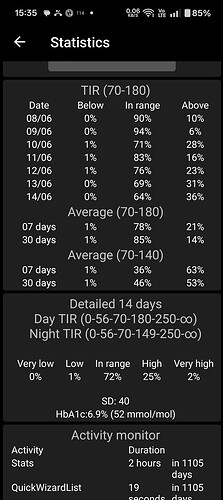What do you have your time in range set at for CGM data?
I used to use 70-150 (3.9-8.3) for TIR, but changed back to the “industry standard” of 70-180 (3.9-10) because its what my Endo and PCP use, but they endorse tighter range control if it’s doable for the person. The Trio dev’s added 70-140 (3.9-7.8) for TITR (Time in Tight Range) to the stats page of their app. I believe TITR was first addressed at the 2019 ATTD conference and several articles over the past year advocate it as a goal.
My personal goal is 90+% TIR and 65+% TITR. I make the first goal a lot of the time when I’m home and can maintain a normal diet, I fall far short when traveling. I fall short of the TITR goal most of the time. Below is a pic of the Trio stats page, I think it’s very similar to an AGP page. While the graphs are good, I think the important line is at the bottom, including GMI, SD, and CV (discussed elsewhere here on FUD). They have their problems, but it’s hard to hide poor BG control with all three. For anyone not familiar with them, a good article on SD and CV is: https://diatribe.org/diabetes-management/understanding-average-glucose-standard-deviation-cv-and-blood-sugar-variability
Keep in mind everyone’s results will vary based on activities, treatments, and life in general. Goals should be hard to achieve, but not impossible, and shouldn’t get in the way of living (I should talk! My wife says I’m a bit “obsessive”!).
I think 70-140 is reasonable. Because realistically, 70-140 on the Dexcom is probably closer to 50-180 for actual BG.
I use 70-160, figuring 160 is halfway between 140 and 180 and I usually notice and attempt to correct a rising high BG after it passes 140 but before it rises past 180. Seemed to make sense as a personal benchmark.
Me, too!
I use AndroidAPS and it uses 70-180. I don’t think there is a way to change that (somewhat unusual for AAPS where pretty much everything can be changed) but AAPS also shows 70-140 and then it has a “Detailed 14 days” with breakdown into 5 bands:
Ha, I forgot to bolus for my afternoon/evening meal yesterday ![]()
Notice that the “Night TIR” for the detailed display is using 150 in place of the 180 used in the “Day TIR”. That seems reasonable to me but I suspect it is partly an AndroidAPS dev thing; they want to know if the program isn’t working when nothing should be messing it up (like my missed bolus, which is what caused the “Very High” - I hit 360 according to Dexcom).
What I don’t like about all this is the 70 (aka 3.9) on the low end. If I’m heading below 80(4.4) I know something bad is happening (night or day) just as if I head past 180 during the day I know something is wrong. When I used a system which let TIR be set (aka Clarity) I set the low to 80.
In fact I much more care about knowing how much my BG has been affecting my functionality than I do about knowing how bad the average is; I have HbA1c for that. So I’m for 80-180 ![]() or 90-150 for TTIR. This is with the Dexcom G7.
or 90-150 for TTIR. This is with the Dexcom G7.
Guys, thanks so much for this. I define my ranges as 75-200 – that’s a wide band. Right now, I’ve been so pleased w/ myself because since taking metformin my TIR has been 100% - but really what I need to do is to narrow the bands - you guys are in much tighter control than me.
e
Thanks, everyone.
I like the perspective of Dr Edelman of https://tcoyd.org/. He’s a T1 himself and advocates pushing yourself for tighter range by setting an alarm for less than the generally accepted 180 top level “so you can do something about it” before you break the ceiling; he advocates for 150. I’m no fan of alarms, but he’s right: being alerted to the rise and being able to do something about it is the key to success, either by a correction bolus (obviously depending on your IOB already) or letting your AID handle it for you based on limits you set.
I’m terrible for turning off my alarms, but agree with the above. I will give it a try. Not today, because I stress ate a bag of kitkats at my Dad’s and am surely going to pay for it, since I didn’t count the carbs and just gave a couple units.
I set tight alarms at night. During the day no alarms as I can easily monitor.
Thanks for the TCOYD recommendation, Tom! Yesterday I started listening to their podcast… and now I’m 6 episodes in and loving it! So refreshing to have the professional endo and personal T1D experience shared together.
I also have mostly had my range at 80-160. Yesterday I dropped my upper alert to 150… ![]()

